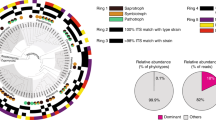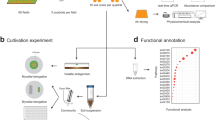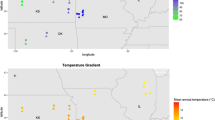Abstract
Understanding the present and future distribution of soil-borne plant pathogens is critical to supporting food and fibre production in a warmer world. Using data from a global field survey and a nine-year field experiment, we show that warmer temperatures increase the relative abundance of soil-borne potential fungal plant pathogens. Moreover, we provide a global atlas of these organisms along with future distribution projections under different climate change and land-use scenarios. These projections show an overall increase in the relative abundance of potential plant pathogens worldwide. This work advances our understanding of the global distribution of potential fungal plant pathogens and their sensitivity to ongoing climate and land-use changes, which is fundamental to reduce their incidence and impacts on terrestrial ecosystems globally.
This is a preview of subscription content, access via your institution
Access options
Access Nature and 54 other Nature Portfolio journals
Get Nature+, our best-value online-access subscription
$29.99 / 30 days
cancel any time
Subscribe to this journal
Receive 12 print issues and online access
$209.00 per year
only $17.42 per issue
Buy this article
- Purchase on Springer Link
- Instant access to full article PDF
Prices may be subject to local taxes which are calculated during checkout




Similar content being viewed by others
Data availability
The data associated with the global field survey and the field experiment are publicly available in Figshare57.
Code availability
Most numerical analyses included in this article do not have an associated code. Used codes are available in Figshare57.
References
Barford E. Crop pests advancing with global warming. Nature https://doi.org/10.1038/nature.2013.13644 (2013).
Newbery, F. et al. Modelling impacts of climate change on arable crop diseases: progress, challenges and applications. Curr. Opin. Plant Biol. 32, 101–109 (2016).
Tollefson, J. IPCC says limiting global warming to 1.5 °C will require drastic action. Nature 562, 172–173 (2018).
Chakraborty, S. & Newton, A. C. Climate change, plant diseases and food security. Plant Pathol. 60, 2–14 (2011).
Moore, D. et al. 21st Century Guidebook to Fungi (Cambridge Univ. Press, 2011).
Nguyen, N. H. et al. FUNGuild: an open annotation tool for parsing fungal community datasets by ecological guild. Fungal Ecol. 20, 241–248 (2016).
Parry, D. W. et al. Fusarium ear blight (scab) in small grain cereals—a review. Plant Pathol. 44, 207–238 (1993).
Qiu, Z. et al. New frontiers in agriculture productivity: optimised microbial inoculants and in situ microbiome engineering. Biotechnol. Adv. 37, 107371 (2019).
Tedersoo, L. et al. Global diversity and geography of soil fungi. Science 346, 1256688 (2014).
Asner, G. P. et al. Grazing systems, ecosystem responses, and global change. Annu. Rev. Environ. Resour. 29, 261–299 (2004).
Maestre, F. T. et al. Structure and functioning of dryland ecosystems in a changing world. Annu. Rev. Environ. Resour. 47, 215–237 (2016).
IPCC Climate Change 2013: The Physical Science Basis (eds Stocker, T. F. et al.) (Cambridge Univ. Press, 2013).
Oliverio, A. M. et al. Identifying the microbial taxa that consistently respond to soil warming across time and space. Glob. Change Biol. 23, 2117–2129 (2017).
Bebber, D. P. et al. The global spread of crop pests and pathogens. Glob. Ecol. Biogeogr. 23, 1398–1407 (2013).
Egidi, E. et al. A few Ascomycota taxa dominate soil fungal communities worldwide. Nat. Commun. 10, 2369 (2019).
De Guevara, M. L. et al. The ‘PhenoBox’, a flexible, automated, open‐source plant phenotyping solution. New Phytol. 219, 808–823 (2018).
Guiot, J. & Wolfgang Cramer, W. Mediterranean warming fast, deserts may spread in Europe. Science 354, 465–468 (2016).
Dean, R. et al. The top 10 fungal pathogens in molecular plant pathology. Mol. Plant Pathol. 13, 414–430 (2012).
Agrios, G. N. Plant Pathology (Academic, 2005).
IPCC Special Report on Land Use, Land-Use Change and Forestry (Cambridge Univ. Press, 2000).
Bell, T. & Tylianakis, J. M. Microbes in the Anthropocene: spillover of agriculturally selected bacteria and their impact on natural ecosystems. Proc. Biol. Sci. 283, 20160896 (2016).
Caliz, J. et al. A long-term survey unveils strong seasonal patterns in the airborne microbiome coupled to general and regional atmospheric circulations. Proc. Natl Acad. Sci. USA 115, 12229–12234 (2018).
Barberan, A. et al. Continental-scale distributions of dust-associated bacteria and fungi. Proc. Natl Acad. Sci. USA 112, 5756–5761 (2015).
Sugden, A. M. Warming, crops, and insect pests. Science 361, 888–889 (2018).
Borrelli, P. et al. An assessment of the global impact of 21st century land use change on soil erosion. Nat. Commun. 8, 2013 (2017).
Panagos, P. et al. The new assessment of soil loss by water erosion in Europe. Environ. Sci. Policy 54, 438 (2015).
World Population Prospects 2019: Highlights (United Nations Department of Economic and Social Affairs, Population Division, 2019).
Delgado-Baquerizo, M. et al. A global atlas of the dominant bacteria found in soil. Science 325, 320–325 (2018).
Steidinger, B. S. et al. Climatic controls of decomposition drive the global biogeography of forest–tree symbioses. Nature 569, 404–408 (2019).
Köhl, J. et al. Epidemiology of dark leaf spot caused by Alternaria brassicicola and A. brassicae in organic seed production of cauliflower. Plant Pathol. 59, 358–367 (2010).
Hijmans, R. J. et al. Very high resolution interpolated climate surfaces for global land areas. Int. J. Clim. 25, 1965–1978 (2005).
Filipponi, F. et al. Global MODIS fraction of green vegetation cover for monitoring abrupt and gradual vegetation changes. Remote Sens. 10, 653 (2018).
Maestre, F. T. et al. Plant species richness and ecosystem multifunctionality in global drylands. Science 335, 214–218 (2012).
Anderson, J. M. & Ingram, J. S. I. (eds) Tropical Soil Biology and Fertility: A Handbook of Methods 2nd edn (CABI, 1993).
Grace, J. B. Structural Equation Modeling Natural Systems (Cambridge Univ. Press, 2006).
Schermelleh-Engel, K. et al. Evaluating the fit of structural equation models: tests of significance and descriptive goodness-of-fit measures. Methods Psychol. Res. 8, 23–74 (2003).
Klaus B. & Strimmer K. Estimation of (Local) False Discovery Rates and Higher Criticism. R package ‘drtool’ version 1.2.15 (2015); https://cran.r-project.org/
Monteleoni, C. et al. Tracking climate models. Stat. Anal. Data Min. 4, 372–392 (2011).
Hempel, S. et al. A trend-preserving bias correction—the ISI–MIP approach. Earth Syst. Dyn. 4, 219–236 (2013).
Lawrence, D. M. et al. The land use model intercomparison project (LUMIP) contribution to CMIP6: rationale and experimental design. Geosci. Model Dev. 9, 2973–2998 (2016).
Kim, H. et al. A protocol for an intercomparison of biodiversity and ecosystem services models using harmonized land-use and climate scenarios. Geosci. Model Dev. 11, 4537–4562 (2018).
Dufresne, J.-L. et al. Climate change projections using the IPSL-CM5 Earth System Model: from CMIP3 to CMIP5. Clim. Dyn. 40, 2123–2165 (2013).
Hurtt, G. C. et al. Harmonization of land-use scenarios for the period 1500–2100: 600 years of global gridded annual land-use transitions, wood harvest, and resulting secondary lands. Clim. Change 109, 117 (2011).
Popp, A. et al. Land-use futures in the shared socio-economic pathways. Glob. Environ. Change 42, 331–345 (2017).
O’Neill, B. C. et al. A new scenario framework for climate change research: the concept of shared socioeconomic pathways. Clim. Change 122, 387–400 (2014).
USGS EROS Archive. Digital Elevation - Global Multi-resolution Terrain Elevation Data 2010 (GMTED2010) (USGS, 2010); https://www.usgs.gov/centers/eros/science/usgs-eros-archive-digital-elevation-global-multi-resolution-terrain-elevation
Maestre F. T. et al. in Biological Soil Crusts: An Organizing Principle in Drylands (eds Weber, Büdel, B. and Belnap, J.) 407–425 (Springer, 2016).
Bowker, M. A. et al. Biological soil crusts (biocrusts) as a model system in community, landscape and ecosystem ecology. Biodivers. Conserv. 23, 1619–1637 (2014).
Castillo-Monroy, A. P. et al. Biological soil crusts modulate nitrogen availability in semi-arid ecosystems: insights from a Mediterranean grassland. Plant Soil 333, 21–34 (2010).
Maestre, F. T. et al. Changes in biocrust cover drive carbon cycle responses to climate change in drylands. Glob. Change Biol. 19, 3835–3847 (2013).
De Castro, M. et al. Evaluación Preliminar de los Impactos en España por Efecto del Cambio Climático (Ministerio Medio Ambiente, 2005).
Edgar, R. C. Search and clustering orders of magnitude faster than BLAST. Bioinformatics 26, 2460–2461 (2010).
Edgar, R. C. UNOISE2: improved error-correction for Illumina 16S and ITS amplicon sequencing. Preprint at https://doi.org/10.1101/081257 (2016).
Kõljalg, U. et al. UNITE: a database providing web-based methods for the molecular identification of ectomycorrhizal fungi. New Phytol. 166, 1063–1068 (2005).
Geiser, D. M. et al. One fungus, one name: defining the genus Fusarium in a scientifically robust way that preserves longstanding use. Phytopathology 103, 400–408 (2013).
Kulik, T. et al. Quantification of Alternaria, Cladosporium, Fusarium and Penicillium verrucosum in conventional and organic grains by qPCR. J. Phytopathol. 163, 522–528 (2015).
Delgado-Baquerizo, M. et al. The Proportion of Soil-borne Pathogens Increases with Warming at the Global Scale https://doi.org/10.6084/m9.figshare.11484747 (2020).
Acknowledgements
This project received funding from the European Union’s Horizon 2020 research and innovation programme under the Marie Sklodowska-Curie grant agreement No 702057 and the European Research Council (ERC) grant agreements no. 242658 (BIOCOM) and no. 647038 (BIODESERT). We thank R. D. Bardgett, N. Fierer, A. Benavent-González and D. J. Eldridge for their original contributions to the global survey, and V. Ochoa, C. Escolar, P. Alonso, B. Gozalo and S. Ochoa for maintaining the warming experiment and for their help with laboratory analyses. We also thank M.S. Martin for revising the English of the manuscript. M.D.-B. is supported by a Ramón y Cajal grant from the Spanish Government (agreement no. RYC2018-025483-I) and a MUSGONET grant (LRA17\1193) from the British Ecological Society. F.T.M. also acknowledges funding from Generalitat Valenciana (CIDEGENT/2018/041) and from sDiv, the synthesis centre of the German Centre for Integrative Biodiversity Research Halle–Jena–Leipzig (iDiv). Work on microbial distribution and colonization in the B.K.S. laboratory is funded by the Australian Research Council (DP190103714). B.K.S. also acknowledges a research award by the Humboldt Foundation. C.A.G. and N.E. acknowledge support from iDiv, funded by the German Research Foundation (DFG FZT118) through flexpool proposals 34600850 and 34600844. N.E. also acknowledges support from the ERC under the European Union’s Horizon 2020 research and innovation programme (grant agreement no. 677232).
Author information
Authors and Affiliations
Contributions
M.D.-B. developed the original idea of the analyses presented in the manuscript. M.D.-B, F.T.M. and B.K.S. led the global survey. F.T.M. designed the field warming experiment and has maintained it over the years. Lab analyses were done by M.D.-B., C.C.-D., E.E., F.T.M. and B.K.S. Bioinformatic analyses were done by B.K.S., J.-T.W. and E.E. Statistical modelling, mapping and data interpretations were done by C.A.G., N.E. and M.D.-B. The manuscript was written by M.D.-B. with contributions from all the co-authors.
Corresponding author
Ethics declarations
Competing interests
The authors declare no competing interests.
Additional information
Peer review information Nature Climate Change thanks Leho Tedersoo and the other, anonymous, reviewer(s) for their contribution to the peer review of this work.
Publisher’s note Springer Nature remains neutral with regard to jurisdictional claims in published maps and institutional affiliations.
Supplementary information
Supplementary Information
Supplementary Appendices 1 and 2, Figs. 1–12 and Tables 1–10.
Rights and permissions
About this article
Cite this article
Delgado-Baquerizo, M., Guerra, C.A., Cano-Díaz, C. et al. The proportion of soil-borne pathogens increases with warming at the global scale. Nat. Clim. Chang. 10, 550–554 (2020). https://doi.org/10.1038/s41558-020-0759-3
Received:
Accepted:
Published:
Issue Date:
DOI: https://doi.org/10.1038/s41558-020-0759-3
This article is cited by
-
Green-fabricated silver nanoparticles from Quercus incana leaf extract to control the early blight of tomatoes caused by Alternaria solani
BMC Plant Biology (2024)
-
Host genotype-specific rhizosphere fungus enhances drought resistance in wheat
Microbiome (2024)
-
Genomic surveillance for antimicrobial resistance — a One Health perspective
Nature Reviews Genetics (2024)
-
Plastiphily is linked to generic virulence traits of important human pathogenic fungi
Communications Earth & Environment (2024)
-
Biological control of soil-borne pathogens in arid lands: a review
Journal of Plant Diseases and Protection (2024)



